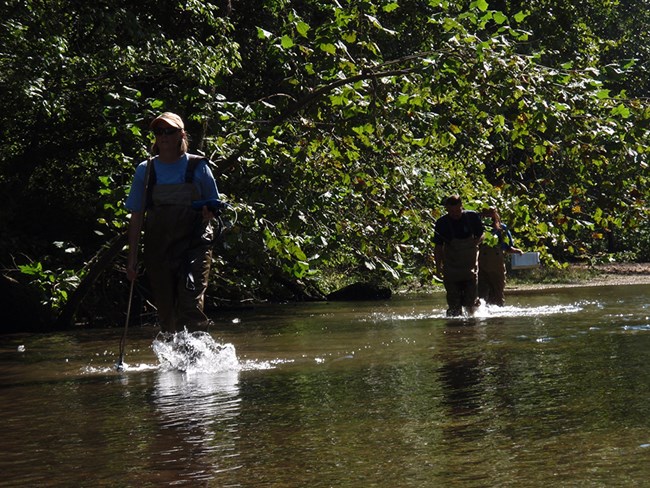
NPS-Photo
Historically, water chemistry data has been used to detect changes or trends in stream quality. However, biomonitoring (use of living organisms to assess water quality) has become a useful and vital tool for stream assessments by providing a more integrated picture of past water quality and habitat conditions. Fish assemblages are an important component of stream/river systems with each species carrying out specific roles in the aquatic community. Assessment of entire fish communities provides information on ecosystem integrity and function. Because land use and management of adjacent lands can have a substantial impact on the quality of streams and rivers in our national parks, the Heartland I&M and Prairie Cluster Prototype Programs began an aquatic monitoring program to detect trends in water quality, physical habitat, and fish assemblage integrity in prairie parks and large river parks.
Monitoring Questions & Approach
- What is the status and long-term trends of fish assemblages in small stream parks and large river parks?
- Annual or rotational fish sampling at these parks to obtain data on number of species present, relative abundance of species, and overall health of the community. Fish are collected with seines or wadeable electrofishing gear in small stream parks and by wadeable and non-wadeable electrofishing techniques in large river parks.
- What is the condition and trends in aquatic habitat in both small stream parks and large river parks?
- Collection of water quality and physical habitat data in conjunction with fish sampling. Temperature, dissolved oxygen, pH, conductivity, and turbidity are measured at each sample site. Point-transect habitat data is collected to obtain information on macrohabitat.
- Within small stream parks containing the endangered Topeka Shiner (Notropis topeka), what is the status and long-term trends of this species?
- Annual fish sampling to determine abundance and trends of this species through time. Habitat sampling to determine the type and condition of habitat for this species.
- Can changes in fish assemblage status or habitat quality be correlated with management regimes?
- Record management actions and land use changes for correlation with fish assemblage and habitat data.
Reports and Protocols
Source: NPS DataStore Collection 3927. To search for additional information, visit the NPS DataStore.
Source: NPS DataStore Collection 4451. To search for additional information, visit the NPS DataStore.
Last updated: May 13, 2025
